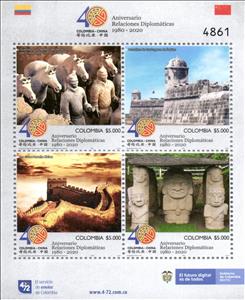Mini Sheet: 40th Anniversary of Diplomatic Relations with China (Colombia 2020)
40th Anniversary of Diplomatic Relations with China (Colombia 2020)
07 February (Colombia ) within release Diplomatic Relations with China, 40th Anniv. goes into circulation Mini Sheet 40th Anniversary of Diplomatic Relations with China face value 4*5000 Colombian peso
| Mini Sheet 40th Anniversary of Diplomatic Relations with China in catalogues | |
|---|---|
| Stamp Number: | Sn: CO 1535 |
| Colnect codes: | Col: CO 2020-02 |
Mini Sheet is vertical format.
Printed by Cartor Security Printings, France. Designed by Mónica Marcela Vargas. Numbered mini sheet of four stamps. Colombia and the People's Republic of China established diplomatic relations on 7 February 1980. During these last 40 years of relations, exchange and cooperation in the cultural, educational, sports, legal and tourism fields has been constantly strengthened. Colombia has a presence in China through its Embassy in Beijing and the Consulates in Hong Kong, Shanghai and Guangzhou and the People's Republic of China does so in Colombia through its Embassy and Consulate in Bogota. D.C.Also in the issue Diplomatic Relations with China, 40th Anniv.:
- Stamp - Terra Cotta Army of Shi Huangdi face value 5,000;
- Stamp - Fortifications of Catagena de las Indias face value 5,000;
- Stamp - Great Wall of China face value 5,000;
- Mini Sheet - 40th Anniversary of Diplomatic Relations with China face value 4*5000;
- Stamp - Pre-Columbian Statues, San Agustin face value 5,000;
Mini Sheet 40th Anniversary of Diplomatic Relations with China it reflects the thematic directions:
Archaeology or archeology[a] is the study of human activity through the recovery and analysis of material culture. The archaeological record consists of artifacts, architecture, biofacts or ecofacts, sites, and cultural landscapes. Archaeology can be considered both a social science and a branch of the humanities. It is usually considered an independent academic discipline, but may also be classified as part of anthropology (in North America – the four-field approach), history or geography
Diplomacy is the main instrument of foreign policy which represents the broader goals and strategies that guide a state's interactions with the rest of the world. International treaties, agreements, alliances, and other manifestations of international relations are usually the result of diplomatic negotiation and processes. Diplomats may also help shape a state by advising government officials.
A fortification (also called a fort, fortress, fastness, or stronghold) is a military construction designed for the defense of territories in warfare, and is used to establish rule in a region during peacetime. The term is derived from Latin fortis ("strong") and facere ("to make").
A statue is a free-standing sculpture in which the realistic, full-length figures of persons or animals are carved or cast in a durable material such as wood, metal or stone. Typical statues are life-sized or close to life-size. A sculpture that represents persons or animals in full figure, but that is small enough to lift and carry is a statuette or figurine, whilst those that are more than twice life-size are regarded as colossal statues.
The United Nations Educational, Scientific and Cultural Organization (UNESCO; pronounced /juːˈnɛskoʊ/) is a specialized agency of the United Nations (UN) with the aim of promoting world peace and security through international cooperation in education, arts, sciences and culture. It has 194 member states and 12 associate members,as well as partners in the non-governmental, intergovernmental and private sector. Headquartered in Paris, France, UNESCO has 53 regional field offices and 199 national commissions




